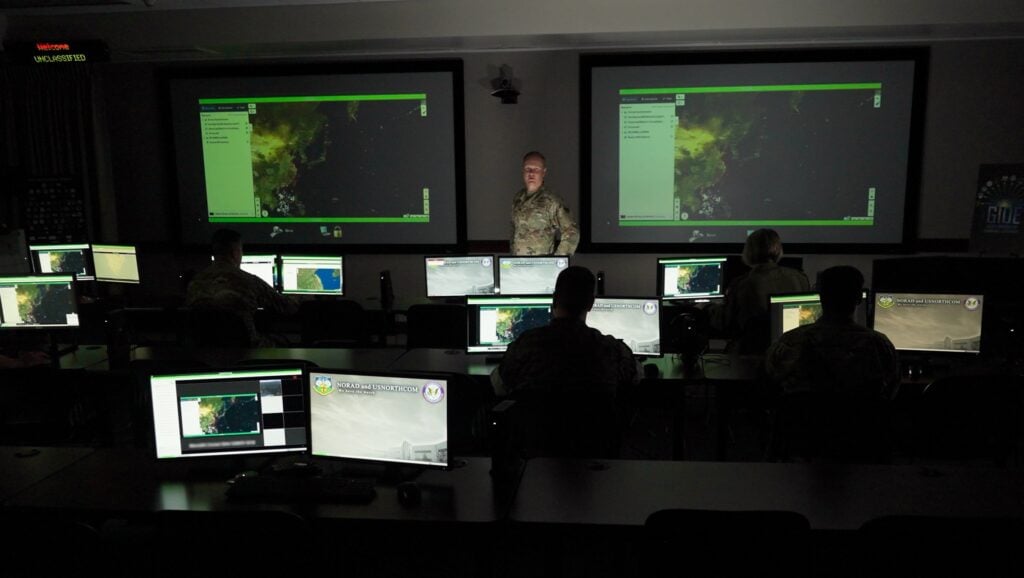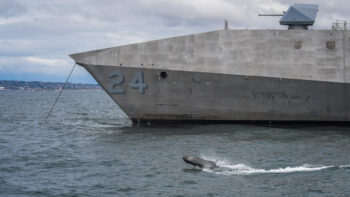
NORTHCOM’s Global Information Dominance Experiment 3 (GIDE 3) testing AI decision aids for commanders ran from July 8-15
WASHINGTON: Gen. Glen VanHerck, the head of US Northern Command, is pushing the Defense Department to rapidly adopt the use of artificial intelligence tools that would give decision-makers earlier, and better, options — not just for defeating an adversary on the battlefield, but for actually avoiding warfare in the first place.
In an exclusive interview this week, VanHerck said AI could help military commanders, US diplomats, allies and partner nations all formulate comprehensive strategies for deterring adversarial global powers, such as Russia and China, in what DoD calls the “gray zone,” also sometimes referred to as the “competition phase” or “left of conflict.”
“It creates options for multiple levers of influence, to be able to coordinate in near real-time to develop global, all-domain dilemmas [for adversaries] to get to deterrence,” said VanHerck, who in his position as NORTHCOM and NORAD head is responsible for defense of the homeland, where obviously the US military would prefer not to have to fight.
As such, “deterrence” is at the center of his mission — and of a series of trials, dubbed Global Information Dominance Experiments (GIDEs) designed as a spur for moving AI capabilities into the hands of commanders as soon as possible.
“What I really want to get out of this is to show the value of data and information, when applied across a global problem set, an all-domain problem set, and how quickly you can generate global dilemmas [for adversaries and], global options for our senior leaders … to create that deterrence we talked about, or de-escalation options, or even in conflict, defeat options,” he said.
Once the final results of NORTHCOM’s third Global Information Dominance Experiment (GIDE 3), which began July 8 and wrapped up today, are in hand, he intends to take his case that AI decision tools are both ready now and urgently needed by Combatant Commanders to both Deputy Defense Secretary Kathleen Hicks and the Vice Chair of the Joint Chiefs of Staff, Gen. John Hyten, who also chairs the Joint Requirements Oversight Council (JROC).
The timing is notable, as the JROC is in the midst of developing cross-service requirements to implement DoD’s new Joint Warfighting Concept (JWC) and the related Joint All Domain Command and Control (JADC2) strategy.
“You know, I’m not a service chief. I don’t have acquisition authority,” the four-star Air Force general said. “Ideally, I can hand this off to somebody in the department to move it forward for future fielding, sustainment, modernization, etc.” But for that to happen, he added, there has to be a cultural shift and “agreement to not use legacy processes and systems to field these kind of capabilities.”
“And, so the way forward, to be honest, I don’t know exactly what that is,” VanHerck admitted. “We’ll figure that out here real soon after GIDE 3, and I’ll talk to the deputy secretary of defense and the vice chairman on the way forward. But I plan to keep going, and keep applying these capabilities to show what’s available now, and to change culture.”
GIDE 3
The GIDE series, as Breaking Defense reported exclusively in in March, are virtual experiments testing software-based decision aids developed for NORTHCOM that use artificial intelligence/machine learning (AI/ML) software to speed commanders’ ability to act. Those same tools — a radar-integration tool; an “information dominance” tool to amalgamate various sensor and even social media inputs; and a “cross-command collaboration” tool that creates a virtual 3D battlefield — were being further refined in GIDE 3.
GIDE 3 was based on a three-phase scenario, beginning in the pre-conflict stage with a peer adversary, that put a heavy focus on managing “contested logistics” — one of the key tenets of the JWC. All 11 Combatant Commands participated in the exercise, and representatives from a couple of allied countries were involved as observers.
In future global warfare with peers, VanHerck explained, “our way of producing power and projecting power will be challenged as we flow forces — whether those forces be through surface vessels, whether they be through air — they will be challenged especially non-kinetically.”
“What this gives us — and what GIDE 3 has already demonstrated — is the ability to rapidly assess the situation to take action when something changes for logistics, where you’re contested,” he went on. “So, say, for example, the Panama Canal became not available. It enables, really quickly, Combatant Commanders to talk about the impact of that, to create options for countering that non-availability, and gives us the ability to assess the risk very quickly of whatever contested logistics impact that you may have.”
Policy Impact
But, VanHerck stressed, the extra time that using machine-speed data crunching to develop a clear picture of adversary activities running up to a potential conflict would be just as important for US policy-makers as for military commanders in the heat of battle.
“Let’s just give you a hypothetical scenario, like that in March, when Russia came down towards the Ukraine and set up their thousands of forces. Let’s just say that you were able to detect that, through the use of the combination of military GEOINT satellites, commercial satellites, signals intelligence, the use of publicly available information such as social media … those kinds of things, and you were able to get three additional days of notification,” he elaborated.
“So, if you’re able to do that before they actually move and get into position, think about the decision space that you now have to give to diplomats — or to give to allies and partners — to posture or to negotiate.”
Because the US didn’t have the ability to gather all that information, rapidly synthesize it and then just as rapidly distribute it during Russia’s March shenanigans, Washington’s response was “reactive, not proactive,” VanHerck said. “Having machines and artificial intelligence … we can collaborate on options to deter, and whether that be State, whether that be DoD, it doesn’t matter, whether it be a partner or an ally.”
Integrated Deterrence
VanHerck further explained that his push for widespread use of AI as a tool for improved decision-making is “100 percent” in alignment with Defense Secretary Lloyd Austin’s pursuit of what DoD now is calling “integrated deterrence.”
“I’m so glad that he is going down an integrated deterrence plan, because deterrence is absolutely integrated with allies, partners, all levers of national power and integrated across all Combatant Commands,” VanHerck said. “That’s what I’m after in this capability. Once you field it, it gives us the ability to create that decision space and create that integrated deterrence.”
In a speech Tuesday at the National Security Commission on Artificial Intelligence (NACAI), Austin explained that the concept is about “using the right mix of technology, operational concepts, and capabilities — all woven together in a networked way that is so credible, flexible, and formidable that it will give any adversary pause.”
Further, Austin said, integrated deterrence involves working even more closely with allies and partners — including on the ethical use of AI as a “force multiplier.”
“Used right, AI capabilities can play a critical role in all four areas of the Joint Warfighting Concept that I approved this spring, including Joint Fires, Joint All Domain Command and Control, Contested Logistics, and Information Advantage,” he said in his written remarks. “Today, across the Department, we have more than 600 AI efforts in progress… significantly more than just a year ago.”






















